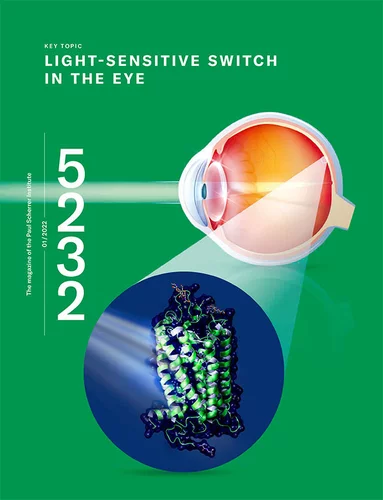Can you see sounds? Obviously not. Nevertheless, this Gallery attempts the seemingly impossible, building a visual bridge to the soundscape the ear perceives all around PSI. Blurred movement hints at the acoustics of one of the world’s most unusual research sites. If you follow the link next to the waveform profile, you can directly hear what you are seeing.
Tak-tak-tak-tak-tak-tak…
What does this noise remind you of? A sewing machine? A train rolling through a rail station? The orbital shaker sits in a biology lab and is used to cultivate eukaryotic cells, human cells for example. With its up to 200 revolutions per minute, it stirs cells and a reddish nutrient fluid in a smooth circular motion. The cells virtually float in the solution and thus are optimally supplied with nutrients and oxygen. Proteins that scientists want to know more about can be selectively extracted from the cell culture. Among these: the spike protein of Sars-CoV-2.
Iiiiiiihhhhhhhhhhh…
This is what you hear in the ventilation center of SwissFEL, Switzerland’s X-ray free-electron laser. It’s the fan that revs up to supply fresh air to the 740-metre-long building, situated in the Würenlinger forest, not far from the PSI campus. At full load, it shovels up to 16,000 cubic metres of air per hour into the building. On the way inside, the air is conditioned to 20 degrees Celsius and precisely regulated to 24 degrees Celsius in the various rooms by means of dozens of air-conditioning units, because temperature fluctuations would falsify the research results. Thus the capability to use X-rays in this large research facility to trace extremely fast processes, such as the formation of molecules, depends in part on its well-tempered fresh air.
Whiiiiiiiiiiiiiiiiiiiiii…
Oh dear! That sounds like a dentist’s drill... But in reality it is a telescopic tube that is part of a cryostat, a cooling device. The tube is extended, approaches a sample of protein crystals, and vaporises liquid nitrogen to keep the crystals chilled to their comfort temperature of minus 173,15 degrees Celsius. At this beamline the structure of proteins is investigated to improve the understanding of general biological processes and, in particular, to enable the development of new drugs. It is one of around 20 beamlines that belong to the Swiss Light Source SLS, which will be upgraded for higher performance by 2026.
Mmmwwwwhooooooooowwwmm...
No doubt about it! That’s a subway train that starts up slowly and comes to a halt a little later. You might think that... At least that’s what we’re told by patients with cancer diseases who come to PSI for treatment at the Centre for Proton Therapy (CPT). The noise is produced when the 180-tonne Gantry 2 is set in motion and a thin beam of protons precisely scans and destroys tumours inside the body. The beam only works where it’s supposed to, so that healthy tissue on either side is protected. CPT has been treating cancer patients successfully for more than 25 years.
Vvvvvschschschschschschschschsch…
Hm!? Maybe a tea kettle... or a bicycle tire that’s losing air... This hissing belongs to a system where liquid nitrogen (LN2) is transferred from a tank into smaller containers on wheels. At this filling station, the nitrogen is at a temperature of a little less than minus 196 degrees Celsius and thus is close to its boiling point. Even when the extensive operating instructions displayed on the sign next to the equipment are followed precisely, harmless amounts of nitrogen leak out, mix with the ambient air, and form a kind of ground fog. Nitrogen is frequently used where the lowest temperatures are required, for example to carry out specific experiments or to cool magnets and power lines.
Text: Christian Heid
Copyright
PSI provides image and/or video material free of charge for media coverage of the content of the above text. Use of this material for other purposes is not permitted. This also includes the transfer of the image and video material into databases as well as sale by third parties.

